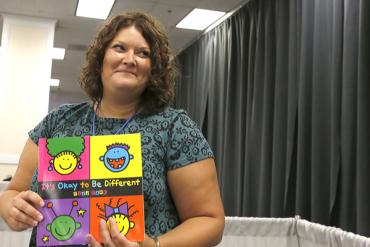Parent involvement in their children's education is best when it begins early, and a refreshing take on that mission was on display at the AFT's recent TEACH (Together Educating America's Children) conference.
In the conference exhibit hall, one of the featured demonstrations came courtesy of Early Head Start teacher Elizabeth Fairweather, an AFT member from Pittsburgh and a participant in the AFT Teacher Leaders Program. She gave educators from across the country a short tutorial on one of the ideas that she hatched in AFT Teacher Leaders—a fresh, new approach to building the home-school connection that she calls "parent buddy bags."
An assortment of colorful, subject-themed satchels filled with books, games and activities that students are invited to share at home, buddy bags have been a hit in Fairweather's class since she introduced them last school year. The early childhood teacher gives her students regular chances to take a bag home for a few nights. During that time, young learners and parents can spend evenings together in fun moments filled with reading, playing and sharing—time that can enrich the learning that goes on in pre-K.
Too often, the pressure of daily life means that parents get caught up "in a drop-off and pick-up" relationship with their preschools, Fairweather notes. The buddy bags have proven to be perfect icebreakers in these situations. And they deliver an important message: "Parents need to be stakeholders in their children's education," particularly when the school day ends.
So far, Fairweather has introduced 16 buddy bags into the classroom. They focus on individual areas: math, science, literacy or gross motor activities. One buddy bag, for example, contains the ever-popular title Chicka Chicka Boom Boom, along with magnetic letters and a tray for display. Parents are encouraged to read the story with their child and, during the reading, highlight letters on the pages. After the reading, they can spend time together placing the magnetic letters on the tray, discovering which ones the child can identify.
It took considerable planning to make their contents interesting, developmentally appropriate and, above all, fun for kids and their families. The strategy all boils down to "short and simple" activities, the teacher explains. Those activities make a difference, and they're available to every parent and child. "A 2-year-old can always tell you something about their day, and you can always read to them for a few minutes each night," Fairweather stresses.
Along with buddy bags, the teacher has used her time in AFT Teacher Leaders to introduce new classroom tools such as simplified, parent-friendly student activity sheets and texting alerts and updates that can be delivered through the "Remind Me" smartphone app. The home-school bonds are stronger, thanks to these approaches, and they are producing stronger results. Attendance in Fairweather's pre-K classroom has soared since she introduced them.
"My hope is that by starting out the new year with these items, we will see a greater growth in parental communication and involvement."
[Mike Rose]

